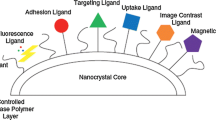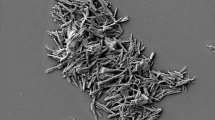Abstract
Formulation of poorly soluble drugs is a general intractable problem in pharmaceutical field, especially those compounds poorly soluble in both aqueous and organic media. It is difficult to resolve this problem using conventional formulation approaches, so many drugs are abandoned early in discovery. Nanocrystals, a new carrier-free colloidal drug delivery system with a particle size ranging from 100 to 1000 nm, is thought as a viable drug delivery strategy to develop the poorly soluble drugs, because of their simplicity in preparation and general applicability. In this article, the product techniques of the nanocrystals were reviewed and compared, the special features of drug nanocrystals were discussed. The researches on the application of the drug nanocrystals to various administration routes were described in detail. In addition, as introduced later, the nanocrystals could be easily scaled up, which was the prerequisite to the development of a delivery system as a market product.






Similar content being viewed by others
References
Allen TM (1997) Liposomes: opportunities in drug delivery. Drugs 54:8–14
Annapragada A, Adjei A (1996) Numerical simulation of milling processes as an aid to process design. Int J Pharm 136:1–11
Blunk T, Hochstrasser DF, Luck MA et al (1996) Kinetics of plasma protein absorption on model particles for controlled drug delivery and drug targeting. Eur J Pharm Biopharm 42:262–268
Böhm BHL, Müller RH (1999) Lab-scale production unit design for nanosuspensions of sparingly soluble cytotoxic drugs. Pharm Sci Tech Today 2:336–339
Borner K, Hartwig H, Leitzke S et al (1999) HPLC determination of clofazimine in tissues and serum of mice after intravenous administration of nanocrystalline or liposomal formulations. Int J Pharm 11:75–79
Choi JY, Yoo JY, Kwak HS et al (2005) Role of polymeric stabilizers for drug nanocrystal dispersions. Curr Appl Phys 5:472–474
Douroumis D, Fahr A (2006) Nano- and micro-particulate formulations of poorly water-soluble drugs by using a novel optimized technique. Eur J Pharm Biopharm 63:173–175
Dressman JB, Amidon GL, Reppas C et al (1998) Dissolution testing as a prognostic tool for oral drug absorption: immediate release dosage forms. Pharm Res 15:11–22
Drews TO, Tsapatsis M (2007) Model of the evolution of nanoparticles to crystals via an aggregative growth mechanism. Micropor Mesopor Mat 101:97–107
Duchene D, Ponchel G (1997) Bioadhesion of solid oral dosage forms, why and how? Eur J Pharm Biopharm 44:15–23
Gassmann P, List M, Schweitzer A et al (1994) Hydrosols-alternatives for the parenteral application of poorly water soluble drugs. Eur J Pharm Biopharm 40:64–72
Geze A, Julienne M, Mathieu D et al (1999) Development of 5-iodo-2%-deoxyuridine milling process to reduce initial burst release from PLGA microparticles. Int J Pharm 178:257–268
Goppert TM, Muller RH (2005) Adsorption kinetics of plasma proteins on solid lipid nanoparticles for drug targeting. Int J Pharm 302:172–186
Grau MJ, Kayser O, Muller RH (2000) Nanosuspensions of poorly soluble drugs – reproducibility of small scale production. Int J Pharm 196:155–157
Gubskaya A, Lisnyak Y, Blagoy Y (1995) Effect of cryogrinding on physico-chemical properties of drugs. I. Theophylline: evaluation of particle sizes and the degree of crystallinity, relation to dissolution parameters. Drug Dev Ind Pharm 21:1953–1964
Hancock BC, Carlson GT, Ladipo DD et al (2002) Comparison of the mechanical properties of the crystalline and amorphous forms of a drug substance. Inter J Pharm 241:73–85
Hecq J, Deleers M, Fanara D et al (2005) Preparation and characterization of nanocrystals for solubility and dissolution rate enhancement of nifedipine. Int J Pharm 299:167–177
Hecq J, Deleers M, Fanara D et al (2006) Preparation and in vitro/in vivo evaluation of nano-sized crystals for dissolution rate enhancement of ucb-35440–3, a highly dosed poorly water-soluble weak base. Eur J Pharm Biopharm 64:360–368
Jacobs C, Kayser O, Muller RH (2000) Nanosuspensions as a new approach for the formulation for the poorly soluble drug tarazepide. Int J Pharm 196:161–164
Jacobs C, Kayser O, Muller RH (2001) Production and characterisation of mucoadhesive nanosuspensions for the formulation of buparvaquone. Int J Pharm 214:3–7
Jacobs C, Muller RH (2002) Production and characterization of a budesonide nanosuspension for pulmonary administration. Pharm Res 19:189–194
Jinno J, Kamada N, Miyake M et al (2006) Effect of particle size reduction on dissolution and oral absorption of a poorly water-soluble drug, cilostazol, in beagle dogs. J Control Release 111:56–64
Kayser O (2001) A new approach for targeting to Cryptosporidium parvum using mucoadhesive nanosuspensions: research and applications. Int J Pharm 214:83–85
Kayser O, Olbrich C, Yardley V et al (2003) Formulation of amphotericin B as nanosuspension for oral administration. Int J Pharm 254:73–75
Keck C, Muller RH (2006) Drug nanocrystals of poorly soluble drugs produced by high pressure homogenisation. Eur J Pharm Biopharm 62:3–16
Kipp JE (2004) The role of solid nanoparticle technology in the parenteral delivery of poorly water-soluble drugs. Int J Pharm 284:109–122
Kocbek P, Baumgartner S, Kristl J. (2006) Preparation and evaluation of nanosuspensions for enhancing the dissolution of poorly soluble drugs. Int J Pharm 312:179–186
Krause KP, Kayser O, Mader K et al (2000) Heavy metal contamination of nanosuspensions produced by high-pressure homogenisation. Int J Pharm 196:169–172
Krause KP, Muller RH (2001) Production and characterisation of highly concentrated nanosuspensions by high pressure homogenisation. Int J Pharm 214:21–24
Lee J, Lee SJ, Choi JY et al (2005) Amphiphilic amino acid copolymers as stabilizers for the preparation of nanocrystal dispersion. Eur J Pharm Sci 24:441–449
Li YCh, Dong L, Jiaa A et al (2006) Preparation and characterization of solid lipid nanoparticles loaded traditional chinese medicine. Int J Biol Macromol 38:296–299
Liedtke S, Wissing S, Muller RH et al (2000) Influence of high pressure homogenization equipment on nanodispersions characteristics. Int J Pharm 196:183–185
Lipinski C (2002) Poor aqueous solubility – an industry wide problem in drug discovery. Am Pharm Rev 5:82–85
Liversidge EM, Liversidge GG, Cooper ER (2003) Nanosizing: a formulation approach for poorly-water-soluble compounds. Eur J Pharm Sci 18:113–120
Liversidge GG, Conzentino P (1995) Drug particle size reduction for decreasing gastric irritancy and enhancing absorption of naproxen in rats. Int J Pharm 125:309–313
Liversidge GG, Cundy KC (1995) Particle size reduction for improvement of oral bioavailability of hydrophobic drugs: I. Absolute oral bioavailability of nanocrystalline danazol in beagle dogs. Int J Pharm 125:91–97
Liversidge GG, Cundy KC, Bishop J, et al (1991) Surface modified drug nanoparticles. US Patent 5145684, 8 Sept 1992
Mantzaris NV (2005) Liquid-phase synthesis of nanoparticles: particle size distribution dynamics and control. Chem Eng Sci 60:4749–4770
Mohammed AR, Weston N, Coombes AGA et al (2004) Liposome formulation of poorly water soluble drugs: optimisation of drug loading and ESEM analysis of stability. Int J Pharm 285:23–34
Mosharraf M, Nystrom C (1995) The effect of particle size and shape on the surface specific dissolution rate of micronized practically insoluble drugs. Int J Pharm 122:35–47
Muller BW, Muller RH (1984) Particle size analysis of latex suspensions and microemulsions by photon correlation spectroscopy. J Pharm Sci 73:915–918
Muller RH, Becker R, Kruss B, et al (1998) Pharmaceutical nanosuspensions for medicament administration as system of increased saturation solubility and rate of solution. US Patent 5858410, 12 Jan 1999
Muller RH, Jacobs C (2002) Buparvaquone mucoadhesive nanosuspension: preparation, optimisation and long-term stability. Int J Pharm 237:151–161
Muller RH, Keck CM (2004) Challenges and solutions for the delivery of biotech drugs – a review of drug nanocrystal technology and lipid nanoparticles. J Biotechnol 113:151–170
Muller RH, Peters K (1998) Nanosuspensions for the formulation of poorly soluble drugs I. Preparation by a size-reduction technique. Int J Pharm 160:229–237
Muller RH, Rungea S, Ravelli V et al (2006) Thunemannc and E. B. Souto. Oral bioavailability of cyclosporine: solid lipid nanoparticles (SLN®) versus drug nanocrystals. Int J Pharm 317:82–89
Na GC, Stevens HJ, Yuan B et al (1999) Physical stability of ethyl diatrizoate nanocrystalline suspension in steam sterilization. Pharm Res 16:569–574
Peters K, Leitzke S, Diederichs JE et al (2000) Preparation of a clofazimine nanosuspension for intravenous use and evaluation of its therapeutic efficacy in murine Mycobacterium avium infection. J Antimicrob Chemoth 45:77–83
Ponchel G, Montisci MJ, Dembri A et al (1997) Mucoadhesion of colloidal particulate systems in the gasrointesinal tract. Eur J Pharm Biopharm 4:25–31
Rabinow BE (2004) Nanosuspensions in drug delivery. Nat Rev Drug Discov 3:785–796
Rasenack N, Muller BW (2003) Micro-size drug particles: common and novel micronization techniques. Pharm Dev Technol 9:1–13
Rosario P, Claudio B, Piera F et al (2002) Eudragit RS100 nanosuspensions for the ophthalmic controlled delivery of ibuprofen. Eur J Pharm Sci 16:53–61
Schmidt S, Müller RH (2003) Plasma protein adsorption patterns on surfaces of Amphotericin B-containing fat emulsions. Int J Pharm 254:3–5
Schwitzera JM, Achleitner G, Pomperb H et al (2004) Development of an intravenously injectable chemically stable aqueous omeprazole formulation using nanosuspension technology. Eur Pharm Biopharma 58:615–619
Siostrom B, Kronberg B, Carlfors J (1993) A method for the preparation of submicron particles of sparingly water-soluble drugs by precipitation in oil-in-water emulsions. 1. influence of emulsification and surfactant concentration. J Pharm Sic 82:579–583
Wallis KH, Muller RH (1993) Determination of the surface hydrophobicity of colloidal dispersions by mini-hydrophobic interaction chromatography. Pharm Ind 55:1124–1128
Xing CS (2004) Preparation and physico-chemical characterization of nanoparticles. In: Xu BH (ed) Nano-medicine. Tsinghua University Publishers, pp 9–10
Zhang DR, Tan TW, Gao L et al (2007) Preparation of Azithromycin Nanosuspensions by High Pressure Homogenization and its Physicochemical Characteristics Studies. Drug Dev Ind Pharm 33:569–575
Zhong J, Shen Zh, Yang Y et al (2005) Preparation and characterization of uniform nanosized cephradine by combination of reactive precipitation and liquid anti-solvent precipitation under high gravity environment. Int J Pharm 301:286–293
Zhang J, Shen Zh, Zhong J et al (2006) Preparation of amorphous cefuroxime axetil nanoparticles by controlled nanoprecipitation method without surfactants. Int J Pharm 323:153–160
Author information
Authors and Affiliations
Corresponding author
Rights and permissions
About this article
Cite this article
Gao, L., Zhang, D. & Chen, M. Drug nanocrystals for the formulation of poorly soluble drugs and its application as a potential drug delivery system. J Nanopart Res 10, 845–862 (2008). https://doi.org/10.1007/s11051-008-9357-4
Received:
Accepted:
Published:
Issue Date:
DOI: https://doi.org/10.1007/s11051-008-9357-4




